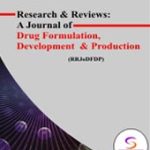
Kaushiki Patel,

Mehak Jain,
- Reseach Scholar Department of Pharmaceutics, Indore Professional Studies Academy, College of Pharmacy Madhya Pradesh India
- Reseach Scholar Department of Pharmaceutics, Indore Professional Studies Academy, College of Pharmacy Madhya Pradesh India
Abstract
In the midst of continuously evolving technologies and mechanized equipment’s, there has been a tremendous growth in the pharmaceutical sector over the past few decades. New technologies, software, devices, and techniques are being developed or researched upon with each passing day. By leveraging pharmacokinetic software, researchers can efficiently analyze vast datasets from preclinical and clinical studies, extracting actionable insights that inform decision-making early in the development cycle. This predictive capability not only accelerates the identification of promising drug candidates but also minimizes the risks associated with unexpected pharmacokinetic profiles in later stages of development. This set of software is medication development based on a model that seeks to increase the rate at which scientist’s analyses data supplying thorough interpretation of reusable streamlined processes, excellent reporting, and presentations. In this review, we have focused on some commonly used software intended for pharmacokinetic studies. Some examples of used software include APIS, AUC-RPP, Biokmod, DATAKINETICS, Edsim++, etc. Using these software’s one may perform pharmacokinetic parameters, pharmacodynamic parameters (PK/PD), and non-compartmental analysis demographics, modelling, bioequivalence, IVIVC, superposition without parameters. One such example of technological advancement in the pharma sector is the development of numerous software to aid in the processes like drug manufacturing, inventory management, management of all typesof records, and Pharmacokinetic and Pharmacodynamic studies. These software’s are briefly explained together with the parameters they are used for and their importance in simplifying pharmacokinetic calculations. A basic description about pharmacokinetic studies is also presented in order to thoroughly understand software employed for these studies. By continuously refining and optimizing pharmacokinetic models based on emerging data, these tools empower pharmaceutical companies to make informed decisions that drive innovation and improve patient outcomes in drug development.
Keywords: Software, pharmacokinetic, pharmacodynamic, bioequivalence, drug development.
References
1. Grogan S, Preuss CV. Pharmacokinetics. 2023 Jul 30. In: StatPearls [Internet]. Treasure Island (FL): StatPearls Publishing; 2024 Jan–. PMID: 32491676. https://www.ncbi.nlm.nih.gov/books/NBK557744/.
2. Arunima G. and Saritha A. Surendran.‘Pharmacokinetic Software: Current Practices’.International Journal of Medical Science and Innovative Research (IJMSIR) 2019; 4(1):312 – 315p.
3. Nordberg M, Duffus J, Templeton DM. Glossary of terms used in toxicokinetics (IUPAC Recommendations 2003). Pure and Applied Chemistry. 2004 Jan 1;76(5):1033-82.
4. Harris P, Nagy S, Vardaxis N. Mosby’s Dictionary of Medicine, Nursing and Health Professions-Australian & New Zealand Edition-eBook. Elsevier Health Sciences; Elsevier Australia 2014 Sep 8.
5. Duffus JH, Nordberg M, Templeton DM. Glossary of terms used in toxicology, (IUPAC Recommendations 2007). Pure and Applied Chemistry. 2007 Jan 1;79(7):1153-344.
6. Hallare, Jericho; Gerriets, Valerie (2023), “Half Life”, StatPearls, Treasure Island (FL): StatPearls Publishing, PMID 32119385, retrieved 2021-12-25.
7. Meibohm B, Derendorf H. Basic concepts of pharmacokinetic/pharmacodynamic (PK/PD) modelling. International journal of clinical pharmacology and therapeutics. 1997 Oct 1;35(10):401-13p.
8. Colburn WA, Lee JW. Biomarkers, validation and pharmacokinetic-pharmacodynamic modelling. Clinical pharmacokinetics. 2003 Oct;42:997-1022p. https://doi.org/10.2165/00003088-200342120-00001
9. Chaikin P, Rhodes GR, Bruno R, Rohatagi S, Natarajan C. Pharmacokinetics/pharmacodynamics in drug development: an industrial perspective. The Journal of Clinical Pharmacology. 2000 Dec;40(12):1428-38.
10. Rajman I. PK/PD modelling and simulations: utility in drug development. Drug discovery today. 2008 Apr 1;13(7-8):341-6.
11. Ruiz-Garcia A, Bermejo M, Moss A, Casabo VG. Pharmacokinetics in drug discovery. Journal of pharmaceutical sciences. 2008 Feb 1;97(2):654-90.
12. Pharmacokinetic Software [Internet]. Pharmpk.com. 2019 [cited 2024 Aug 11]. Available from: https://www.pharmpk.com/soft.html
13. Zou H, Banerjee P, Leung SS, Yan X. Application of pharmacokinetic-pharmacodynamic modelling in drug delivery: development and challenges. Frontiers in pharmacology. 2020 Jul 3;11:997
14. Colucci, Philippe, and Murray P. Ducharme. “Applications of Software Packages in Pharmacokinetics.” Applied Biopharmaceutics & Pharmacokinetics, 7e Eds. Leon Shargel, and Andrew B.C. Yu. McGraw-Hill Education, 2016, https://accesspharmacy.mhmedical.com/content.aspx?bookid=1592§ionid=100668824.
15. Weiner D, Gabrielsson J. PK24 – Non-linear kinetics – flow II”. Pharmacokinetic/pharmacodynamic data analysis: concepts and applications. Apotekarsocieteten. 2000 July, 527–36.
16. Charles G, Duffull SB. Pharmacokinetic software for the health sciences: choosing the right package for teaching purposes. Clinical pharmacokinetics. 2001 Jun;40:395-403.
17. Benet LZ, Galeazzi RL. Noncompartmental determination of the steady‐state volume of distribution. Journal of pharmaceutical sciences. 1979 Aug 1;68(8):1071-4.
18. Rowland M, Benet LZ, Graham GG. Clearance concepts in pharmacokinetics. Journal of pharmacokinetics and biopharmaceutics. 1973 Apr;1(2):123-36.
19. Rowland M and Tozer TN. Clinical Pharmacokinetics. Lea and Febiger, Philadelphia. 1989 :135-162.
20. Huang XH, Zheng QS. Pharmacokinetic and Pharmacodynamic Data Analysis: Concepts and Applications. Am J Pharm Educ. 2010 Apr 12;74(3):53b. PMCID: PMC2865421.
21. Nair S, Kong AN. Emerging roles for clinical pharmacometrics in cancer precision medicine. Current pharmacology reports. 2018 Jun;4:276-83.
22. Volles DF, McGory R. Pharmacokinetic considerations. Critical care clinics. 1999 Jan 1;15(1):55-75.
23. Chen B, Abuassba AO. Compartmental models with application to pharmacokinetics. Procedia Computer Science. 2021 Jan 1;187:60-70.
24. Shumaker RC, Boxenbaum H, Thompson GA. ABSPLOTS: a LOTUS 123 spreadsheet for calculating and plotting drug absorption rates. Pharm Res. 1988 Apr;5(4):247-8. doi: 10.1023/a:1015954032126. PMID: 3247304.
25. Guiastrennec B, Wollenberg L, Forrest A, Ait‐Oudhia S. AMGET, an R‐based postprocessing tool for ADAPT 5. CPT: Pharmacometrics & Systems Pharmacology. 2013 Jul;2(7):1-0.
| Volume | |
| Received | July 19, 2024 |
| Accepted | August 16, 2024 |
| Published | September 2, 2024 |


